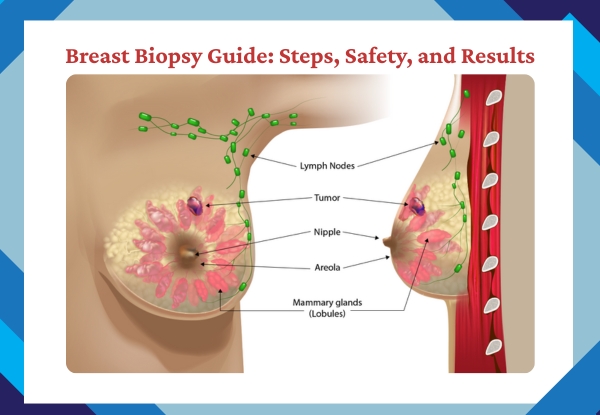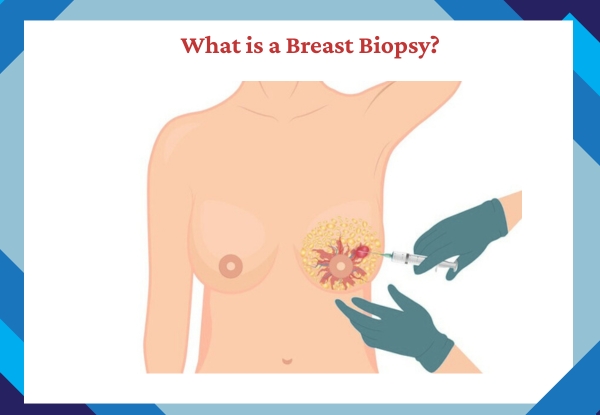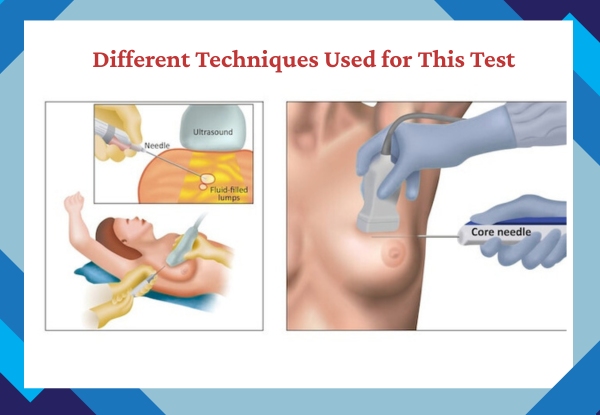
Finding a lump or an abnormal area in the breast can be concerning. Naturally, questions arise. Is it cancer? Is it harmless? What’s the next step? This is where a breast biopsy becomes important. A biopsy helps doctors confirm exactly what’s happening inside the breast tissue. It’s a medically approved way to check whether a lump or change is cancerous or benign.
Unlike assumptions based only on scans, a biopsy gives a clear diagnosis by studying actual cells from your breast. This helps your doctor plan the right treatment or reassure you if there’s no serious issue. In this blog, we’ll walk you through everything you need to know what happens during the test, why it’s done, how to prepare, and how it helps detect breast cancer early, if present.
What is a Breast Biopsy?

A breast biopsy is a diagnostic procedure used to examine abnormal breast tissue. Doctors recommend it when a mammogram or ultrasound shows something that needs closer inspection. It’s not always a sign of cancer many times, the lump or irregularity can be harmless. The test helps confirm if the cells are benign (non-cancerous) or malignant (cancerous), allowing your healthcare provider to recommend appropriate treatment or follow-up.
Common reasons to recommend this test include
- Suspicious lumps felt during a breast exam
- Unusual spots or shadows in a mammogram
- Nipple discharge or skin changes
- Family history of breast cancer
Early diagnosis can help manage health risks effectively. If you’ve been advised to get a breast biopsy test, it’s normal to feel nervous. However, knowing how the test works can help ease anxiety.
Why Breast Biopsy is Important
A biopsy provides accurate information that no imaging test can confirm alone. While scans are useful for identifying irregularities, only a biopsy can determine the nature of a suspicious area.
Here’s why the test matters:
- Differentiates between benign and malignant lumps
- Helps decide if treatment is required
- Guides the next medical step with clarity
Ignoring a suspicious lump is never advisable. A timely biopsy can make a big difference in outcomes.
Why the Test Matters for Women’s Health
Detecting abnormalities in the breast early on can prevent unnecessary complications. A biopsy provides direct answers, removing doubts about what’s going on inside the breast tissue. This clarity helps avoid both under-treatment and over-treatment.
Here’s why getting this test when advised is important:
- Helps distinguish harmless lumps from serious conditions
- Allows early planning of treatment if required
- Prevents the delay of timely care
- Provides peace of mind in many cases where the lump is benign
Sometimes, people wait too long to follow up on a suspicious finding, hoping it will resolve on its own. But delays can cost time that is otherwise useful for early treatment. If advised, the biopsy is a step in the right direction.
Common Reasons for Recommending a Breast Biopsy
Doctors don’t suggest a biopsy without good reason. It’s part of a careful diagnostic process that begins with imaging and physical evaluation. If an abnormality persists or seems concerning, a biopsy becomes the logical next step.
Situations where this test is commonly suggested:
- Detection of a hard lump during self-examination or doctor visit
- Imaging results showing shadows or calcifications
- Persistent pain in one specific area
- Swelling or skin dimpling that does not resolve
- Family history of breast-related cancers or conditions
- Previous biopsy with uncertain or abnormal results
In such cases, the biopsy helps give a clearer view of what’s happening inside the body.
Different Techniques Used for This Test

Not all breast biopsies are the same. The procedure used depends on several factors, including the visibility of the lump on imaging, its location, and whether it’s deep or near the surface.
Types of biopsy procedures include:
1. Fine Needle Aspiration (FNA)
This method uses a very thin needle to extract fluid or cells. It’s often used when the lump is likely to be a cyst or filled with liquid. It’s quick and requires minimal recovery time.
2. Core Needle Biopsy
A thicker needle is used to remove small cylinders of tissue. It offers more detail than FNA and is often used when solid tissue samples are needed for accurate diagnosis.
3. Ultrasound-Guided Biopsy
For lumps visible on ultrasound, this type uses real-time imaging to guide the needle. It’s precise and avoids unnecessary damage to surrounding tissue.
4. Stereotactic Biopsy
This method uses mammography images to locate the exact position of the abnormality. It’s particularly useful when the irregularity isn’t felt but is seen on a scan.
5. Surgical Biopsy
This is done when other methods are not possible or results are unclear. A surgeon removes all or part of the suspicious area for analysis. While more invasive, it may be required in select cases.
Each of these approaches serves a unique purpose. The type recommended will depend on individual medical conditions and diagnostic needs.
How the Procedure is Performed
Understanding what happens during the biopsy can reduce stress for those undergoing the procedure. Most breast biopsies are outpatient procedures, meaning you don’t need to stay in the hospital.
Here’s what to expect on the day of the test:
- The doctor will explain the process and address your concerns
- Local anaesthesia is given to numb the area
- Imaging equipment such as ultrasound or mammogram may be used to guide the needle
- A small tissue sample is collected
- Pressure is applied to minimise bleeding
- A bandage is placed, and post-care instructions are given
The whole process usually takes less than an hour. Some discomfort or bruising is normal but generally settles within a few days. Pain medication is rarely needed, but if required, mild over-the-counter options are usually enough.
Care and Recovery After the Test
After the biopsy, proper care helps minimise discomfort and lowers the chance of complications. Most people return to normal activities within a day or two.
Simple steps for smoother recovery include:
- Resting for a few hours post-procedure
- Avoiding heavy lifting for at least 24–48 hours
- Keeping the area dry as instructed
- Using cold compresses if swelling appears
- Wearing a supportive bra for added comfort
In most cases, side effects are minor. However, you should contact your doctor if you notice redness, discharge, or fever, as these may signal infection.
Interpreting the Results
Once the sample is tested, your healthcare provider will discuss the results with you. It’s important to understand that not all findings are serious. In many cases, the result is benign, and no further action is required apart from regular monitoring.
Possible outcomes include:
- Benign: No cancer; tissue is normal or non-threatening
- Atypical: Cells show some irregularity; further testing may be needed
- Malignant: Cancer cells present; treatment planning begins
Regardless of the outcome, the clarity provided by the biopsy allows you and your healthcare team to make informed decisions.
Choosing the Right Place for Testing
Choosing the best diagnostic center for a biopsy plays a major role in the quality and reliability of the test. Accurate imaging, experienced staff, and proper sample handling all influence the final outcome.
A good diagnostic service will offer:
- Well-maintained imaging and testing facilities
- Trained radiologists and pathologists
- Proper hygiene standards
- Transparent and clear communication
- Timely delivery of results
If you’re looking for a trusted facility, Midas Care Clinic is known for reliable and professional services, offering both accuracy and patient comfort.
Myths and Misunderstandings
Many people feel anxious about getting a biopsy due to common myths. Understanding the truth can help you stay calm and confident.
Common misunderstandings include:
- “Biopsy means I have cancer.”
Not true. Many biopsies result in non-cancerous findings. - “The needle will spread the cancer.”
This is a myth. The test is done carefully with proven safe techniques. - “It’s extremely painful.”
Local anaesthesia reduces pain. You may feel pressure but not sharp pain.
Clearing up doubts helps people make better decisions about their health.
FAQs
Q1. What does a breast biopsy test detect?
Answer: It checks for abnormal cells in breast tissue, helping to identify if they’re cancerous or benign.
Q2. Is the breast biopsy procedure painful?
Answer: Mild discomfort may occur, but local anaesthesia is given. Pain is generally minimal and short-lived.
Q3. How long does it take to get results?
Answer: Most labs provide results within 3 to 5 working days.
Q4. Can I go to work after the biopsy?
Answer: Yes, for most types you can resume regular tasks within a day, unless advised otherwise by your doctor.
Q5. Are there any side effects of a biopsy?
Answer: Bruising, soreness, or mild swelling can happen, but these usually go away in a few days.
Q6. Will I need further tests after a biopsy?
Answer: If the results show abnormal or unclear findings, your doctor may request additional tests or even a surgical biopsy.
Q7. Is it safe to delay a biopsy?
Answer: Delaying it is not recommended. Timely diagnosis can help avoid complications.

